Pheidole morrisii
| Pheidole morrisii | |
|---|---|

| |
| Scientific classification | |
| Kingdom: | Animalia |
| Phylum: | Arthropoda |
| Class: | Insecta |
| Order: | Hymenoptera |
| Family: | Formicidae |
| Subfamily: | Myrmicinae |
| Tribe: | Attini |
| Genus: | Pheidole |
| Species: | P. morrisii |
| Binomial name | |
| Pheidole morrisii Forel, 1886 | |
| Synonyms | |
| |
This is a locally abundant species that prefers pure sand, where it often builds crater mounds or nests at the base of grass clumps. According to Naves (1985), colonies are large and live primarily as scavengers, although they also occasionally collect seeds. Workers have been observed foraging as much as 8 meters or more from the nests. Minors forage singly at night, with majors often emerging from the nest to help carry back food. Nest-founding queens build vertical passageways to a claustral chamber 20–30 cm below the surface, and use the excavated soil of the chamber to plug the passageway. Naves observed rapid growth in incipient colonies: the first minors emerge in 30 days, the first majors in 50 days, with colonies growing to several hundred workers in 8 months. In New York winged queens are present in nests during July, and in Florida as early as May (Stefan Cover, unpublished records). Cover (personal communication) has also noted that morrisi “shows a fascinating variation in life history over its large geographic range. Populations in the northeast (Long Island and New Jersey pine barrens) have pleometrotic colony founding, and exhibit primary polygyny—one of the very few documented cases in the ants. Colonies are almost always monodomous. In the southeastern United States, morrisi is haplometrotic and monogynous but colonies are often polydomous.” (Wilson 2003)
| At a Glance | • Polygynous |
Identification
See the description in the nomenclature section.
Keys including this Species
Distribution
Long Island, New York south to South Florida, and west to Illinois, Missouri, Oklahoma, and Texas. (Wilson 2003)
Latitudinal Distribution Pattern
Latitudinal Range: 41.649482° to 25.72149°.
| North Temperate |
North Subtropical |
Tropical | South Subtropical |
South Temperate |
- Source: AntMaps
Distribution based on Regional Taxon Lists
Nearctic Region: United States (type locality).
Distribution based on AntMaps
Distribution based on AntWeb specimens
Check data from AntWeb
Countries Occupied
| Number of countries occupied by this species based on AntWiki Regional Taxon Lists. In general, fewer countries occupied indicates a narrower range, while more countries indicates a more widespread species. |

|
Estimated Abundance
| Relative abundance based on number of AntMaps records per species (this species within the purple bar). Fewer records (to the left) indicates a less abundant/encountered species while more records (to the right) indicates more abundant/encountered species. |

|
Biology
Naves (1985) - P. morrisi is a common species in Florida It always nests in the ground and the colonies are quite large. It is a monogynous species and is primarily a scavenger.
Several nest founding females displayed singular habits in the laboratory which may not have been noted previously in this genus. In constructing the claustral chamber each female used the soil dug from the bottom of the vertical passageway to form a continuous plug of the passageway above her rather than bringing the soil particles to the surface. The claustral chamber at the 20 to 30 cm level below ground thus is entirely sealed from the surface by a long plug I interpret this habit as a defense mechanism against various predators during the claustral period The first workers are reared in about 30 days and the first majors in about 50 days.
The colony increases in size rapidly. In 8 months it can have several hundred workers and majors. The workers forage alone, although the majors can help to bring food back to the colony once food is located Workers can forage over 8 m from the nesting site. The species is mainly a scavenger but will also gather seeds.
This species is known to remove seeds (Atchison & Lucky, 2022; Stamp & Lucus, 1990).
Flight Period
| X | X | ||||||||||
| Jan | Feb | Mar | Apr | May | Jun | Jul | Aug | Sep | Oct | Nov | Dec |
Source: antkeeping.info.
- Check details at Worldwide Ant Nuptial Flights Data, AntNupTracker and AntKeeping.
 Explore: Show all Flight Month data or Search these data. See also a list of all data tables or learn how data is managed.
Explore: Show all Flight Month data or Search these data. See also a list of all data tables or learn how data is managed.
Life History Traits
- Queen number: polygynous (Frumhoff & Ward, 1992)
Castes
Minor Worker
Images from AntWeb
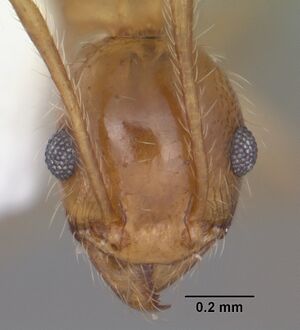 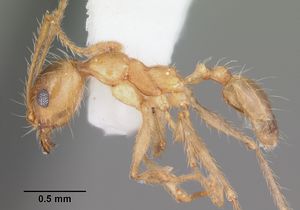  
| |
| Worker. Specimen code casent0104416. Photographer April Nobile, uploaded by California Academy of Sciences. | Owned by ABS, Lake Placid, FL, USA. |
Major Worker
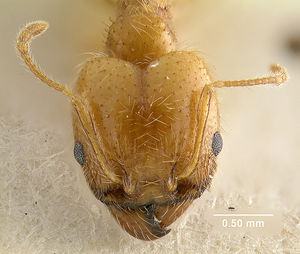  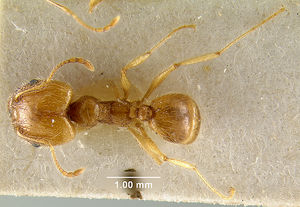     
| |
| . | Owned by Museum of Comparative Zoology. |
Male
Images from AntWeb
 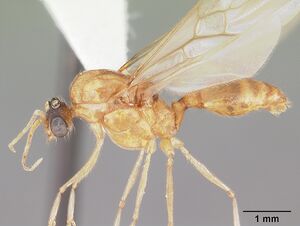   
| |
| Male (alate). Specimen code casent0104417. Photographer April Nobile, uploaded by California Academy of Sciences. | Owned by ABS, Lake Placid, FL, USA. |
Nomenclature
The following information is derived from Barry Bolton's Online Catalogue of the Ants of the World.
- morrisii. Pheidole morrisii Forel, 1886b: xlvi (s.w.) U.S.A. Forel, 1901e: 350 (q.m.); Wheeler, G.C. & Wheeler, J. 1960b: 12 (l.). Senior synonym of vanceae: Creighton, 1950a: 183; of impexa: Wilson, 2003: 325. See also: Feener, 1987: 569.
- vanceae. Pheidole morrisii var. vanceae Forel, 1901e: 351 (s.w.q.m.) U.S.A. Junior synonym of morrisii: Creighton, 1950a: 183.
- impexa. Pheidole morrisi var. impexa Wheeler, W.M. 1908e: 461, pl. 27, fig. 31 U.S.A. Subspecies of morrisii: Creighton, 1950a: 184. Junior synonym of morrisii: Wilson, 2003: 325.
Unless otherwise noted the text for the remainder of this section is reported from the publication that includes the original description.
Description
From Wilson (2003): A member of the fallax group easily distinguished by the following traits.
Major: yellow; antennal scape approaches occipital corner within 2! its own width; propodeal spines reduced to denticles; rugoreticulum lacking on head; pilosity dense and very long, many hairs longer than Eye Length; postpetiole from above elliptical, with subangulate lateral borders.
Minor: yellow; propodeal spines reduced to right or obtuse angles; occiput slightly narrowed, with thin nuchal crest. The types of impexa differ from typical eastern morrisi in having two-layered gastral pilosity, flattened scape at the bend, and a more narrowly tapered petiolar node in the major. I have treated the form as a western geographic variant, i.e., from Oklahoma and Texas, but it may prove to be a distinct species.
MEASUREMENTS (mm) Major (Selden, New York): HW 1.26, HL 1.26, SL 0.88, EL 0.24, PW 0.62. Minor (Selden, New York): HW 0.60, HL 0.82, SL 0.90, EL 0.16, PW 0.40.
COLOR Major: concolorous yellow.
Minor: yellow, with head and mesosoma a slightly darker shade than rest of body and appendages.
Figure. Upper: major. Lower: minor. NEW YORK: Selden, Suffolk Co. Scale bars = 1 mm.
Type Material
Vineland, New Jersey. Musee d'Histoire Naturelle Genève - as reported in Wilson (2003)
Etymology
Eponymous. (Wilson 2003)
References
- Atchison, R. A., Lucky, A. 2022. Diversity and resilience of seed-removing ant species in Longleaf Sandhill to frequent fire. Diversity 14, 1012 (doi:10.3390/d14121012).
- Carroll, T.M. 2011. The ants of Indiana (Hymenoptera: Formicidae). M.S. thesis, Purdue University.
- Creighton, W. S. 1950a. The ants of North America. Bulletin of the Museum of Comparative Zoology 104: 1-585 (page 183, senior synonym of vancecae)
- Davis, T. 2009. The ants of South Carolina (thesis, Clemson University).
- Feener, D. H., Jr. 1987. Response of Pheidole morrisi to two species of enemy ants, and a general model of defense behavior in Pheidole. J. Kans. Entomol. Soc. 60: 569-575 (page 569, see also)
- Forel, A. 1886b. Espèces nouvelles de fourmis américaines. Ann. Soc. Entomol. Belg. 30:xxxviii-xlix. (page xlvi, soldier, worker described)
- Forel, A. 1901j. Variétés myrmécologiques. Ann. Soc. Entomol. Belg. 45: 334-382 (page 350, queen, male described)
- Ipser, R.M., Brinkman, M.A., Gardner, W.A., Peeler, H.B. 2004. A survey of ground-dwelling ants (Hymenoptera: Formicidae) in Georgia. Florida Entomologist 87: 253-260.
- MacGown, J.A., Booher, D., Richter, H., Wetterer, J.K., Hill, J.G. 2021. An updated list of ants of Alabama (Hymenoptera: Formicidae) with new state records. Transactions of the American Entomological Society 147: 961-981 (doi:10.3157/061.147.0409).
- Murdock, T.C., Tschinkel, W.R. 2015. The life history and seasonal cycle of the ant, Pheidole morrisi Forel, as revealed by wax casting. Insectes Sociaux 62, 265–280 (doi:10.1007/s00040-015-0403-9).
- Naves, M. A. 1985. A monograph of the genus Pheidole in Florida, USA (Hymenoptera: Formicidae). Insecta Mundi 1: 53–90.
- Stamp, N.E., Lucas, J.R. 1990. Spatial patterns and dispersal distances of explosively dispersing plants in Florida sandhill vegetation. Journal of Ecology 78, 589–600.
- Tschinkel, W.R. 2015. The architecture of subterranean ant nests: beauty and mystery underfoot. Journal of Bioeconomics 17:271–291 (DOI 10.1007/s10818-015-9203-6).
- Wheeler, G. C.; Wheeler, J. 1960b. Supplementary studies on the larvae of the Myrmicinae (Hymenoptera: Formicidae). Proc. Entomol. Soc. Wash. 62: 1-32 (page 12, larva described)
- Wilson, E. O. 2003. Pheidole in the New World: A dominant, hyperdiverse ant genus. Harvard University Press, Cambridge, MA. (page 325, fig. major, minor described, Senior synonym of impexa)
References based on Global Ant Biodiversity Informatics
- Annotated Ant Species List Ordway-Swisher Biological Station. Downloaded at http://ordway-swisher.ufl.edu/species/os-hymenoptera.htm on 5th Oct 2010.
- Atchison R. A., J. Hulcr, and A. Lucky. 2018. Managed fire frequency significantly influences the litter arthropod community in longleaf pine flatwoods. Environmental Entomology 20(10): 1-11.
- Braman C. A., and B. T. Forschler. 2018. Survey of Formicidae attracted to protein baits on Georgia’s Barrier Island dunes. Southeastern Naturalist 17(4): 645-653.
- Carroll T. M. 2011. The ants of Indiana (Hymenoptera: Formicidae). Master's Thesis Purdue university, 385 pages.
- Coovert, G.A. 2005. The Ants of Ohio (Hymenoptera: Formicidae) Ohio Biological Survey Bulletin New Series Volume 15(2):1-196
- Davis W. T., and J. Bequaert. 1922. An annoted list of the ants of Staten Island and Long Island, N. Y. Bulletin of the Brooklyn Entomological Society 17(1): 1-25.
- Del Toro, I. 2010. PERSONAL COMMUNICATION. MUSEUM RECORDS COLLATED BY ISRAEL DEL TORO
- Deyrup M. 2016. Ants of Florida: identification and natural history. CRC Press, 423 pages.
- Deyrup M., C. Johnson, G. C. Wheeler, J. Wheeler. 1989. A preliminary list of the ants of Florida. Florida Entomologist 72: 91-101
- Deyrup M., L. Deyrup, and J. Carrel. 2013. Ant Species in the Diet of a Florida Population of Eastern Narrow-Mouthed Toads, Gastrophryne carolinensis. Southeastern Naturalist 12(2): 367-378.
- Deyrup, M. and J. Trager. 1986. Ants of the Archbold Biological Station, Highlands County, Florida (Hymenoptera: Formicidae). Florida Entomologist 69(1):206-228
- Epperson, D.M. and C.R. Allen. 2010. Red Imported Fire Ant Impacts on Upland Arthropods in Southern Mississippi. American Midland Naturalist, 163(1):54-63.
- Feener D.H.,Jr. 1987. Response of Pheidole morrisi to two species of enemy ants, and a general model of defense behavior in Pheidole. Journal of the Kansas Entomological Society 60: 569-575.
- Forel A. 1901. Variétés myrmécologiques. Annales de la Société Entomologique de Belgique 45: 334-382.
- Forster J.A. 2005. The Ants (hymenoptera: Formicidae) of Alabama. Master of Science, Auburn University. 242 pages.
- Frye J. A., T. Frye, and T. W. Suman. 2014. The ant fauna of inland sand dune communities in Worcester County, Maryland. Northeastern Naturalist, 21(3): 446-471.
- Graham J.H., H.H. Hughie, S. Jones, K. Wrinn, A.J. Krzysik, J.J. Duda, D.C. Freeman, J.M. Emlen, J.C. Zak, D.A. Kovacic, C. Chamberlin-Graham, H. Balbach. 2004. Habitat disturbance and the diversity and abundance of ants (Formicidae) in the Southeastern Fall-Line Sandhills. 15pp. Journal of Insect Science. 4: 30
- Graham, J.H., A.J. Krzysik, D.A. Kovacic, J.J. Duda, D.C. Freeman, J.M. Emlen, J.C. Zak, W.R. Long, M.P. Wallace, C. Chamberlin-Graham, J.P. Nutter and H.E. Balbach. 2008. Ant Community Composition across a Gradient of Disturbed Military Landscapes at Fort Benning, Georgia. Southeastern Naturalist 7(3):429-448
- Gregg R. E. 1945 (1944). The ants of the Chicago region. Annals of the Entomological Society of America 37: 447-480
- Guénard B., K. A. Mccaffrey, A. Lucky, and R. R. Dunn. 2012. Ants of North Carolina: an updated list (Hymenoptera: Formicidae). Zootaxa 3552: 1-36.
- Ipser R. M. 2004. Native and exotic ants (Hymenoptera: Formicidae) of Georgia: Ecological Relationships with implications for development of biologically-based management strategies. Doctor of Philosophy thesis, University of Georgia. 165 pages.
- Ivanov K., L. Hightower, S. T. Dash, and J. B. Keiper. 2019. 150 years in the making: first comprehensive list of the ants (Hymenoptera: Formicidae) of Virginia, USA. Zootaxa 4554 (2): 532–560.
- Jeanne R. J. 1979. A latitudinal gradient in rates of ant predation. Ecology 60(6): 1211-1224.
- Johnson C. 1986. A north Florida ant fauna (Hymenoptera: Formicidae). Insecta Mundi 1: 243-246
- King J. R. 2007. Patterns of co-occurrence and body size overlap among ants in Florida's upland ecosystems. Ann. Zool. Fennici. 44: 189-201
- Klotz, J.H., J.R. Mangold, K.M. Vail, L.R. Davis Jr., R.S. Patterson. 1995. A survey of the urban pest ants (Hymenoptera: Formicidae) of Peninsular Florida. Florida Entomologist 78(1):109-118
- Lubertazzi D. and Tschinkel WR. 2003. Ant community change across a ground vegetation gradient in north Floridas longleaf pine flatwoods. 17pp. Journal of Insect Science. 3:21
- Lynch J. F. 1988. An annotated checklist and key to the species of ants (Hymenoptera: Formicidae) of the Chesapeake Bay region. The Maryland Naturalist 31: 61-106
- MacGown J. A., J. G. Hill, and M. Deyrup. 2009. Ants (Hymenoptera: Formicidae) of the Little Ohoopee River Dunes, Emanuel County, Georgia. J. Entomol. Sci. 44(3): 193-197.
- MacGown, J.A and J.A. Forster. 2005. A preliminary list of the ants (Hymenoptera: Formicidae) of Alabama, U.S.A. Entomological News 116(2):61-74
- MacGown, J.A. and JV.G. Hill. Ants of the Great Smoky Mountains National Park (Tennessee and North Carolina).
- Naves M. A. 1985. A monograph of the genus Pheidole in Florida, USA (Hymenoptera: Formicidae). Insecta Mundi 1: 53-90
- Nuhn, T.P. and C.G. Wright. 1979. An Ecological Survey of Ants (Hymenoptera: Formicidae) in a Landscaped Suburban Habitat. American Midland Naturalist 102(2):353-362
- O'Keefe S. T., J. L. Cook, T. Dudek, D. F. Wunneburger, M. D. Guzman, R. N. Coulson, and S. B. Vinson. 2000. The Distribution of Texas Ants. The Southwestern Entomologist 22: 1-92.
- Oyama L., J. R. King, and D. G. Jenkins. 2018. Diversity and distribution of Solenopsis (Hymenoptera: Formicidae) thief ants belowground. Myrmecological News 27: 47-57.
- Roeder K. A., and D. V. Roeder. 2017. The Pheidole (Hymenoptera: Formicidae) of Oklahoma: new species records and distributional notes. Check List 13(2): 2071.
- Smith M. R. 1934. A list of the ants of South Carolina. Journal of the New York Entomological Society 42: 353-361.
- Smith M. R., and W. A. Morrison. 1916. South Carolina ants. Entomological News 27: 110-111.
- Trager, J. and C.Johnson. 1985. A slave-making ant in Florida: Polyergus lucidus with observations on the natural history of its host Formica archboldi (Hymenoptera: Formicidae). The Florida Entomologist 68(2):261-266.
- Van Pelt A. F. 1948. A Preliminary Key to the Worker Ants of Alachua County, Florida. The Florida Entomologist 30(4): 57-67
- Van Pelt A., and J. B. Gentry. 1985. The ants (Hymenoptera: Formicidae) of the Savannah River Plant, South Carolina. Dept. Energy, Savannah River Ecology Lab., Aiken, SC., Report SRO-NERP-14, 56 p.
- Warren, L.O. and E.P. Rouse. 1969. The Ants of Arkansas. Bulletin of the Agricultural Experiment Station 742:1-67
- Wetterer, J.K. and J.A. Moore. 2005. Red Imported Fire Ants (Hymenoptera: Formicidae) at Gopher Tortoise (Testudines: Testudinidae) Burrows. The Florida Entomologist 88(4):349-354
- Wheeler G. C., and J. Wheeler J. 1989. A checklist of the ants of Oklahoma. Prairie Naturalist 21: 203-210.
- Wheeler W. M. 1904. The ants of North Carolina. Bulletin of the American Museum of Natural History. 20: 299-306.
- Wheeler, G.C. and J. Wheeler. 1985. A checklist of Texas ants. Prairie Naturalist 17:49-64.
- Whitcomb W. H., H. A. Denmark, A. P. Bhatkar, and G. L. Greene. 1972. Preliminary studies on the ants of Florida soybean fields. Florida Entomologist 55: 129-142.
- Wilson, E.O. 2003. Pheidole in the New World: A Dominant, Hyperdiverse Genus. Harvard University Press
- Yang A-s. 2006. Seasonality, division of labor, and dynamics of colony-level nutrient storage in the ant Pheidole morrisi. Insectes Sociaux 53:456-462
- Young J., and D. E. Howell. 1964. Ants of Oklahoma. Miscellaneous Publication. Oklahoma Agricultural Experimental Station 71: 1-42.
- Young, J. and D.E. Howell. 1964. Ants of Oklahoma. Miscellaneous Publications of Oklahoma State University MP-71


